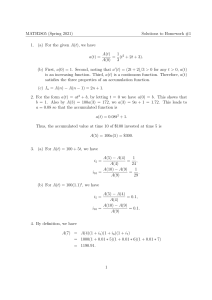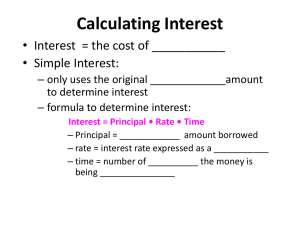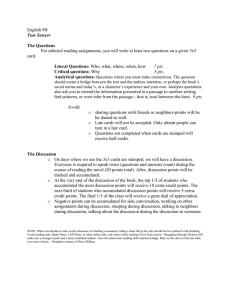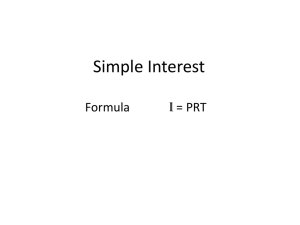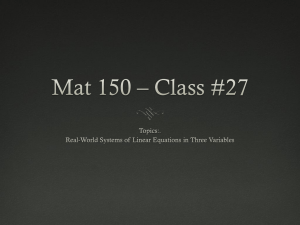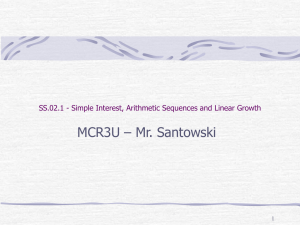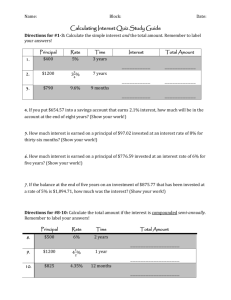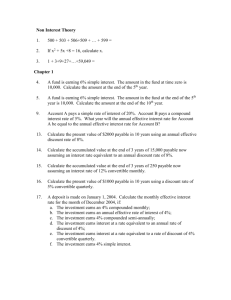Math 325 Chapter 1 – The Measurement of Interest Interest:
advertisement
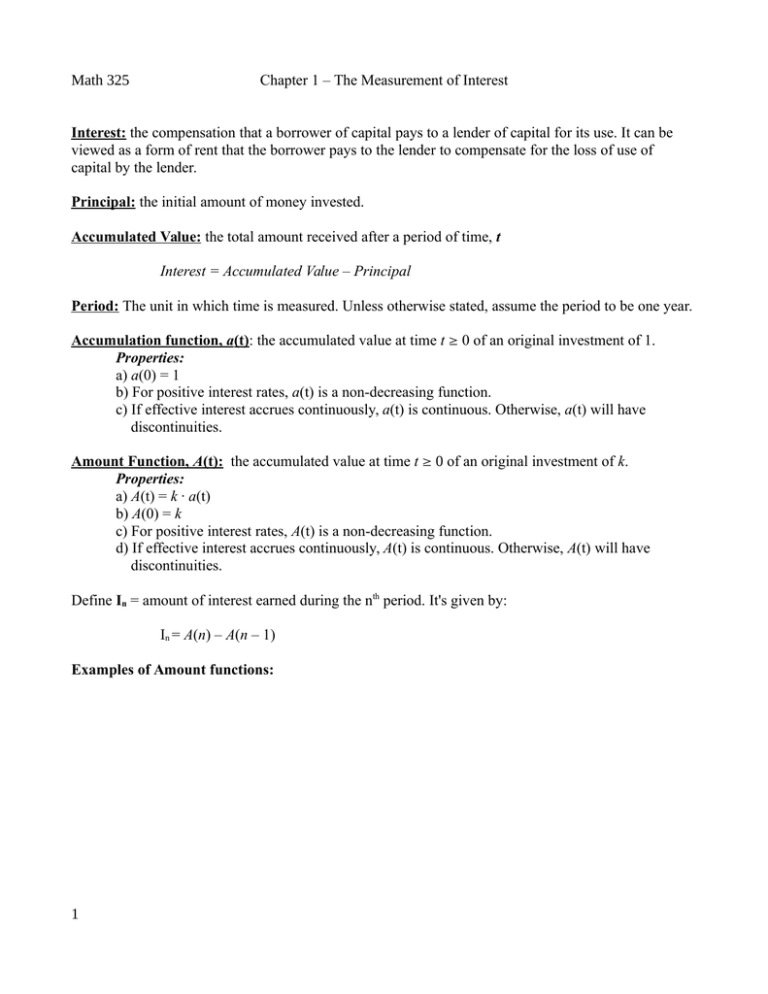
Math 325 Chapter 1 – The Measurement of Interest Interest: the compensation that a borrower of capital pays to a lender of capital for its use. It can be viewed as a form of rent that the borrower pays to the lender to compensate for the loss of use of capital by the lender. Principal: the initial amount of money invested. Accumulated Value: the total amount received after a period of time, t Interest = Accumulated Value – Principal Period: The unit in which time is measured. Unless otherwise stated, assume the period to be one year. Accumulation function, a(t): the accumulated value at time t ³ 0 of an original investment of 1. Properties: a) a(0) = 1 b) For positive interest rates, a(t) is a non-decreasing function. c) If effective interest accrues continuously, a(t) is continuous. Otherwise, a(t) will have discontinuities. Amount Function, A(t): the accumulated value at time t ³ 0 of an original investment of k. Properties: a) A(t) = k · a(t) b) A(0) = k c) For positive interest rates, A(t) is a non-decreasing function. d) If effective interest accrues continuously, A(t) is continuous. Otherwise, A(t) will have discontinuities. Define In = amount of interest earned during the nth period. It's given by: In = A(n) – A(n – 1) Examples of Amount functions: 1 Math 325 Chapter 1 – The Measurement of Interest Effective rate of interest, i: the amount of money that 1 unit invested at the beginning of a period will earn during the period, where interest is paid at the end of the period. i = a(1) – a(0), or a(1) = 1 + i Observations about the definition a) “effective” is used for rates of interest in which interest is paid once per measurement period. b) Effective rate of interest is often expressed as a percentage, e.g. i= 8% is equivalent to 0.08 earned per unit of principal. c) The amount of principal remains constant throughout the period. d) The interest is paid at the end of the period. 2 Math 325 Chapter 1 – The Measurement of Interest Example 1. An investment of $10,000 is made into a fund at time t = 0. The fund develops the following balances over the next 4 years: t A(t) 0 10,000 1 10,600 2 11,130 3 11,575 4 12,153 a) Find the effective rate of interest for each of the four years. b) If $5000 is invested at time t = 2, under the same interest environment, find the accumulated value of the $5000 at time t = 4. 3 Math 325 Chapter 1 – The Measurement of Interest Example 2. It is known that a(t) is of the form ae0.09t + b. If $250 invested at time 0 accumulates to $257.10` at time 5, find the accumulated value at time 12 of $250 invested at time 3. 4 Math 325 Chapter 1 – The Measurement of Interest Simple Interest With simple interest, the amount of interest earned during each period is constant. a(t) = 1 + it for t = 1, 2, 3,... A constant rate of simple interest does not imply a constant effective rate of interest. Amount function A(t) for Simple Interest Example 3. Find the accumulated value of $3500 invested for 10 years if the simple interest rate is 4% per annum. 5 Math 325 Chapter 1 – The Measurement of Interest Compound Interest: interest is automatically reinvested to earn additional interest. a(t) = (1 + i)t for t = 1, 2, 3,... A constant rate of simple interest implies a constant effective rate of interest and that the two are equal. Note: Unless stated otherwise, we will assume that interest is accrued over functional periods according to a(t) = 1 + it for simple interest, and a(t) = (1 + i)t for compound interest. Example 4. Find the accumulated value of $100 at the end of 3 years and 8 months invested at 7% per annum. Example 5. Rework example 4 assuming simple interest during the final fractional period. Example 7. Which of the two accumulated values is higher – one in example 4 or example 5. Explain. 6 Math 325 Chapter 1 – The Measurement of Interest Present Value: We have seen that an investment of 1 will accumulate to 1 + i at the end of one period. 1 + i is known as the accumulation factor. Now consider: How much should be invested initially, so that the balance will be 1 at the end of one period? Let that initial amount be x. • v is called the discount factor, since it “discounts” the value of an investment at the end of the period to its value at the beginning of the period. • How much should be invested initially such that the balance is 1 at the end of t periods? The discount factor is denoted by a– 1(t). We get, for t ³ 0, For simple interest : a– 1(t) = For compound interest : a– 1(t) = 7 Math 325 Chapter 1 – The Measurement of Interest Example 8. If an investment of $1000 will grow to $6000 after 20 years, find the sum of present values of two payments of $9000 each, which will occur at the end of 30 and 50 years, assuming the same interest rate. 8
